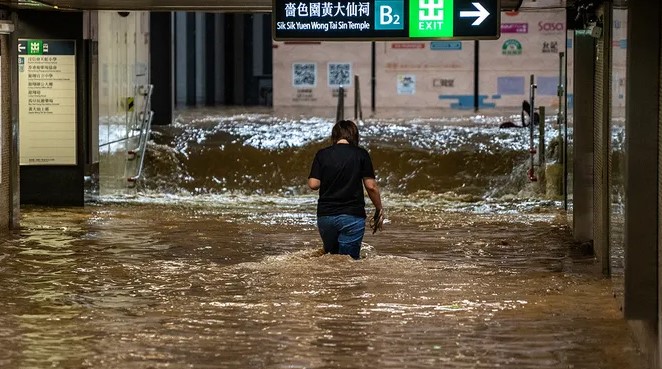On Friday, torrential rain inundated Hong Kong, causing widespread flooding throughout the densely populated city. Streets, shopping malls, and metro stations were submerged, prompting authorities to close schools and advise workers to stay home.
The Chinese special administrative region experienced its highest hourly rainfall in 140 years, with cascading water descending from the city’s mountainous areas. Authorities issued warnings of potential landslides as the city struggled to cope with the deluge.
Videos on social media depicted streets transformed into torrents of water. One clip showed metro workers wading through waist-deep water in a station, attempting to control the floodwaters pouring in from the surface.
The city’s cross-harbor tunnel, a key link between Hong Kong Island and Kowloon, was also flooded, and a shopping center in Chai Wan was shown completely waterlogged.

The Hong Kong Observatory reported 158.1 millimeters (6.2 inches) of rainfall from 11 p.m. HKT on Thursday to midnight on Friday. The weather bureau issued a “black” rainstorm warning, indicating over 200 mm of rain had fallen across Hong Kong’s main island, Kowloon, and the northeastern New Territories since Thursday night.
The downpour, attributed to the remnants of Typhoon Haikui, has affected the Guangdong coast of China as well. Extreme weather conditions are expected to persist until at least noon on Friday.
As a result, Hong Kong’s stock exchange will be closed for the morning session and will remain shut for the afternoon if the “black” rainstorm warning continues. City leader John Lee expressed deep concern over the flooding, directing all departments to respond with maximum effort.
Flooding also led to the suspension of some border control points with Shenzhen. In Wong Tai Sin, vehicles were submerged while attempting to navigate main roads.
The MTR Corp reported closures and delays on its rail network. All schools were suspended due to the severe flooding and traffic disruptions, with the government urging employers to follow work arrangements similar to those used for a strong wind signal 8, which typically halts city operations.

